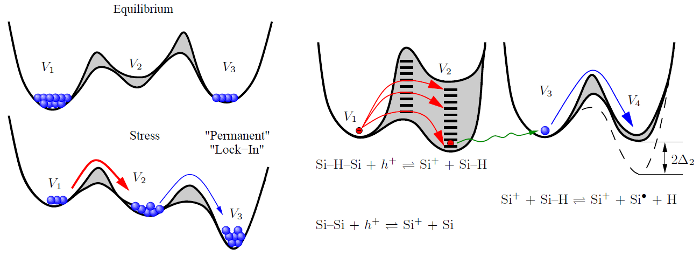8.3 Coupled Double-Well Model
Up to now the appearance of oxide traps and interface states was explained by
independent processes adding up as the two components which have been
empirically introduced in Chapter 4, i.e. the recoverable and the more or less
permanent part of the BTI degradation. Results by Grasser et al. indicate that
their inducing processes are coupled since their effect cannot be separated by the
application of different stress voltages and stress temperatures [134]. By using the
basic well-structure of the triple-well model [77], which was already mentioned in
Chapter 3.2.1 and is depicted in Fig. 8.3 (left), a new model was introduced
consisting of two weakly coupled double-wells [134], cf. Fig. 8.3 (right). During
stress holes near the interface can be first trapped to act as a precursor for the
creation of an interface state. The corresponding reactions are shown in
Fig. 8.3 (right) and are based on an oxygen vacancy and a  bridge,
respectively [135, 136]. Upon the existence of
bridge,
respectively [135, 136]. Upon the existence of  precursors, the second
process, i.e. the release of a hydrogen atom, is assumed to be considerably
enhanced due to the weaker binding energy of
precursors, the second
process, i.e. the release of a hydrogen atom, is assumed to be considerably
enhanced due to the weaker binding energy of  , compared to that of
, compared to that of
 .
The resulting dangling bonds are poorly recoverable and so account for the
demanded permanent component [134].
.
The resulting dangling bonds are poorly recoverable and so account for the
demanded permanent component [134].
The major improvement of the coupled double-well lies in the thermally
activated hole capture process featuring a dispersive process necessary to explain
the wide time scales observed in measurements [11, 134]. Moreover, with this
model it was possible to explain a huge amount of experimental stress and
relaxation data covering various temperatures, stress voltages, and even device
technologies. Unfortunately the physical nature of the coupling inbetween
the double-wells remains unclear. This is because a model explaining
this coupling requires the consideration of the microscopic behavior of
defects.
 bridge,
respectively [135, 136]. Upon the existence of
bridge,
respectively [135, 136]. Upon the existence of  precursors, the second
process, i.e. the release of a hydrogen atom, is assumed to be considerably
enhanced due to the weaker binding energy of
precursors, the second
process, i.e. the release of a hydrogen atom, is assumed to be considerably
enhanced due to the weaker binding energy of  , compared to that of
, compared to that of
 2.
The resulting dangling bonds are poorly recoverable and so account for the
demanded permanent component [134].
2.
The resulting dangling bonds are poorly recoverable and so account for the
demanded permanent component [134].

 is
energetically higher than the first and the third well and forms a transitional
saddle point.
is
energetically higher than the first and the third well and forms a transitional
saddle point.  and
and  are energetically favored and get filled. Since the barrier between
are energetically favored and get filled. Since the barrier between  and
and
 is higher than between
is higher than between  and
and  during relaxation (not shown but
comparable to top left), transitions from the second well back to the first well
are fast, while the third well represents the permanent component/lock-in.
during relaxation (not shown but
comparable to top left), transitions from the second well back to the first well
are fast, while the third well represents the permanent component/lock-in.
 bridge or an oxygen vacancy (
bridge or an oxygen vacancy ( ) via a thermally activated process. This
captured hole then triggers the release of the hydrogen atom which creates
a dangling bond (right double-well).
) via a thermally activated process. This
captured hole then triggers the release of the hydrogen atom which creates
a dangling bond (right double-well).